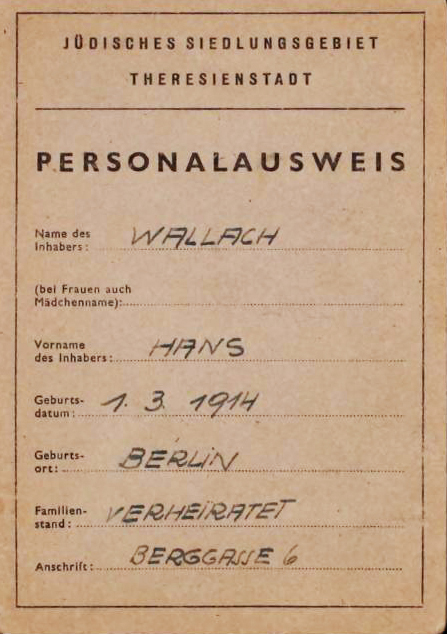Hans and Hildegard Wallach
Marion Novack, New York 2010
In an old, faded, black and white photograph, my mother is standing on the doorstep of a white house with a thatched roof. More than 60 years after the photo was taken, I visited that house, the house my parents lived in when they were taken prisoner by the Gestapo in Assens, Denmark in 1943.
My parents, Hans and Hildegard Wallach fled Berlin and the Nazis in 1938. They were members of Hechaluz and went to Denmark as agricultural trainees to learn farming so they would acquire the necessary skills to emigrate to Palestine. They, and the 26 other members of their group, were taken prisoner by the Gestapo in Assens in the raid of October 2, 1943. My mother described their capture in a letter she wrote to me in 1978: “We were picked up at 5 o’clock in the morning in big buses. We had been warned the night before by the Hechaluz that there was a possibility that the Nazis would find us out in the country where all of our group were working for those lovely farmers. I was seven months pregnant. Seeing all of our other friends in the bus calmed me down somehow. The ugly thing was that we had to pick up, on two other farms, the two children of our friends. The children were brought to those farm families a night or two before the raid. It was terrible. The farmers did not want to give the kids to the Gestapo, but they would have been shot. There was, of course, no choice. All of us had plenty of bread, butter, salami and cheese supplied during the raid, from farm to farm, by the farmers. We even had enough left over and could give a little to some of our roommates in the camp. We were 460 people in the Danish transport. The rest of the Jewish Danes found out in time and fled with the help of fishermen and others to Sweden by night. People with no money were taken also. No questions asked from the beautiful Danes.”
The Hechaluz group and Danish Jews who were also captured, were deported to Theresienstadt. My sister, Rachel, was born in the camp, January 1, 1944. My family was rescued by the Swedish Red Cross in 1945, and returned to Denmark. I was born there in March 1946 and our family emigrated to the U.S. in December 1947.
In 2007, the cousin of my dear friend Renee, introduced me, via e-mail, to Gerda, a friend of hers who is a retired historian in Denmark. Gerda generously offered her help to identify the farmers so I could contact them or their families to let them know their kindness was still remembered and appreciated. Her research provided the names plus a wealth of information I never knew regarding the years my parents were in Denmark. Hedegaard Peterson was identified as the owner of Volbrogaard, the farm where my parents worked in 1943. Like my parents, the Petersons had died many years ago. However, using the Internet, I located their eldest daughter, Britta. I also found Den Gamle Skole, (the old school house), which was my first home.
My visit to Denmark in May was an emotional and exciting journey of discovery. Britta and I bonded quickly over shared stories, old photographs, laughter and tears. She remembered her mother explaining that items stored in a chest “belonged to a Jewish family that had to leave Denmark for a time”. The most poignant moment of the trip was standing on the doorstep of the house where my mother had stood 67 years earlier. As my husband digitized the moment, I tearfully thought of my parents leaving this house and boarding the Gestapo’s bus waiting for them on Egerupvej, the narrow, quiet street I was facing. Later, visiting Voldbrogaard, I stood inside the barn on the same cobblestones my father had walked on long ago and thought of a photo of him behind a horse and plow, working in a field which Britta had identified as belonging to Voldbrogaard. For a fleeting moment, I felt he was there with me.
A highlight of the trip was visiting Gerda to thank her in person for her time and efforts which had made my parents’ lives in Denmark more real and meaningful to me.
And with special excitement, I visited Den Gamle Skole in Kalundborg and took photographs of where I had lived and played as a young child.
When I began my search, I had no idea that I would take this extraordinary journey into my parents’ past and create a memorable story, a story of discovery and the friends, old and new, who helped bridge my parents’ past to my present.
To be continued.
